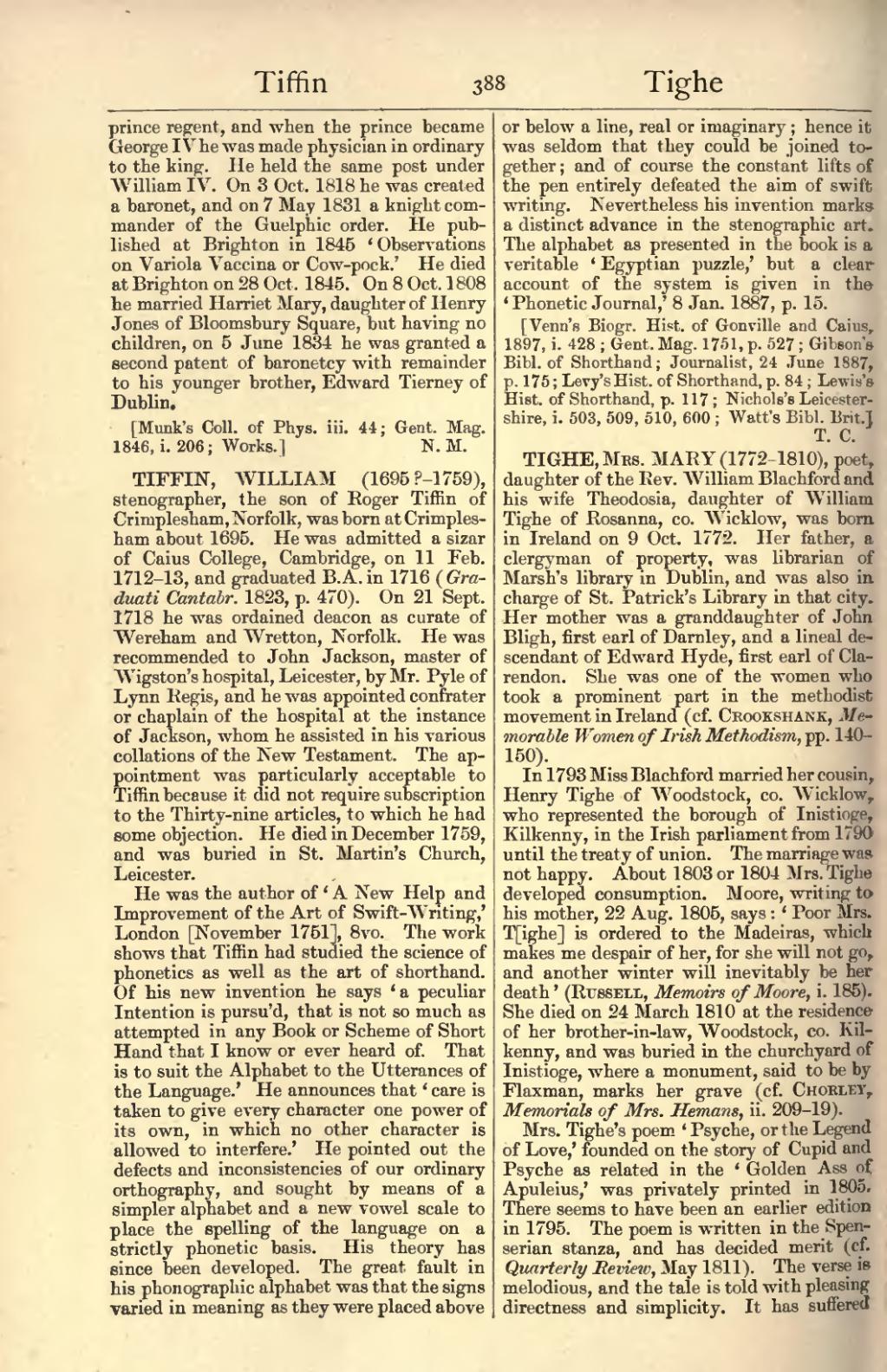prince regent, and when the prince became George IV he was made physician in ordinary to the king. He held the same post under William IV. On 3 Oct. 1818 he was created a baronet, and on 7 May 1831 a knight commander of the Guelphic order. He published at Brighton in 1845 ‘Observations on Variola Vaccina or Cow-pock.’ He died at Brighton on 28 Oct. 1845. On 8 Oct. 1808 he married Harriet Mary, daughter of Henry Jones of Bloomsbury Square, but having no children, on 5 June 1834 he was granted a second patent of baronetcy with remainder to his younger brother, Edward Tierney of Dublin.
[Munk's Coll. of Phys. iii. 44; Gent. Mag. 1846, i. 206; Works.]
TIFFIN, WILLIAM (1695?–1759), stenographer, the son of Roger Tiffin of Crimplesham, Norfolk, was born at Crimplesham about 1695. He was admitted a sizar of Caius College, Cambridge, on 11 Feb. 1712–13, and graduated B.A. in 1716 (Graduati Cantabr. 1823, p. 470). On 21 Sept. 1718 he was ordained deacon as curate of Wereham and Wretton, Norfolk. He was recommended to John Jackson, master of Wigston's hospital, Leicester, by Mr. Pyle of Lynn Regis, and he was appointed confrater or chaplain of the hospital at the instance of Jackson, whom he assisted in his various collations of the New Testament. The appointment was particularly acceptable to Tiffin because it did not require subscription to the Thirty-nine articles, to which he had some objection. He died in December 1759, and was buried in St. Martin's Church, Leicester. He was the author of ‘A New Help and Improvement of the Art of Swift-Writing,’ London [November 1751], 8vo. The work shows that Tiffin had studied the science of phonetics as well as the art of shorthand. Of his new invention he says ‘a peculiar Intention is pursu'd, that is not so much as attempted in any Book or Scheme of Short Hand that I know or ever heard of. That is to suit the Alphabet to the Utterances of the Language.’ He announces that ‘care is taken to give every character one power of its own, in which no other character is allowed to interfere.’ He pointed out the defects and inconsistencies of our ordinary orthography, and sought by means of a simpler alphabet and a new vowel scale to place the spelling of the language on a strictly phonetic basis. His theory has since been developed. The great fault in his phonographic alphabet was that the signs varied in meaning as they were placed above or below a line, real or imaginary; hence it was seldom that they could be joined together; and of course the constant lifts of the pen entirely defeated the aim of swift writing. Nevertheless his invention marks a distinct advance in the stenographic art. The alphabet as presented in the book is a veritable ‘Egyptian puzzle,’ but a clear account of the system is given in the ‘Phonetic Journal,’ 8 Jan. 1887, p. 15.
[Venn's Biogr. Hist. of Gonville and Caius, 1897, i. 428; Gent. Mag. 1751, p. 527; Gibson's Bibl. of Shorthand; Journalist, 24 June 1887, p. 175; Levy's Hist. of Shorthand, p. 84; Lewis's Hist. of Shorthand, p. 117; Nichols's Leicestershire, i. 503, 509, 510, 600; Watt's Bibl. Brit.]
TIGHE, Mrs. MARY (1772–1810), poet, daughter of the Rev. William Blachford and his wife Theodosia, daughter of William Tighe of Rosanna, co. Wicklow, was born in Ireland on 9 Oct. 1772. Her father, a clergyman of property, was librarian of Marsh's library in Dublin, and was also in charge of St. Patrick's Library in that city. Her mother was a granddaughter of John Bligh, first earl of Darnley, and a lineal descendant of Edward Hyde, first earl of Clarendon. She was one of the women who took a prominent part in the methodist movement in Ireland (cf. Crookshank, Memorable Women of Irish Methodism, pp. 140–150).
In 1793 Miss Blachford married her cousin, Henry Tighe of Woodstock, co. Wicklow, who represented the borough of Inistioge, Kilkenny, in the Irish parliament from 1790 until the treaty of union. The marriage was not happy. About 1803 or 1804 Mrs. Tighe developed consumption. Moore, writing to his mother, 22 Aug. 1805, says: ‘Poor Mrs. T[ighe] is ordered to the Madeiras, which makes me despair of her, for she will not go, and another winter will inevitably be her death’ (Russell, Memoirs of Moore, i. 185). She died on 24 March 1810 at the residence of her brother-in-law, Woodstock, co. Kilkenny, and was buried in the churchyard of Inistioge, where a monument, said to be by Flaxman, marks her grave (cf. Chorley, Memorials of Mrs. Hemans, ii. 209–19).
Mrs. Tighe's poem ‘Psyche, or the Legend of Love,’ founded on the story of Cupid and Psyche as related in the ‘Golden Ass of Apuleius,’ was privately printed in 1805. There seems to have been an earlier edition in 1795. The poem is written in the Spenserian stanza, and has decided merit (cf. Quarterly Review, May 1811). The verse is melodious, and the tale is told with pleasing directness and simplicity. It has suffered
